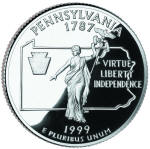Newsletter Issue 78 - August 2015
In this issue:
Pennslvania Trademark
Personal essay on the female inventor
Five Steps for Registering a Trademark in Pennsylvania

We've written about the benefits of state trademark registration.
There aren't many but if you believe state registration is right for
you, here's a brief guide on how to register your trademark in
Pennsylvania.
Pennsylvania trademark law closely tracks some of the same
principles, which apply to federal trademarks. These include the
definition of trademarks and service marks, use of the International
Classification System with respect to assigning trademarks to
classes of goods and services; and the requirement that a trademark
be used in the ordinary course of trade. Unlike federal trademarks,
there is no provision to register a trademark on an "intent to use"
basis. Also, as a side note, state trademarks are renewable every
five years, you may abandon a state registered trademark by not
using it, and your trademark is subject to cancellation should
another trademark user consider your registration infringing. All
the rules are embodied in the Pennsylvania Trademark Act.
Step 1 - Determine that the "trademark" you wish to register is
actually a trademark
A "trademark" under Pennsylvania law is defined as "any word, name,
symbol or device, or any combination thereof, used by a person to
identify and distinguish the goods of such person, including a
unique product, from those manufactured or sold by others and to
indicate the source of the goods even if that source is unknown."
"Service marks" are defined as "any word, name, symbol or devise or
any combination thereof used by a person to identify and distinguish
the services of one person, including a unique service, from the
services of others and to indicate the source of the services even
if that source is unknown."
A "trade name," on the other hand, is defined as a "word, name,
symbol, device or any combination thereof used by a person to
identify the business, vocation or occupation of the person and
distinguish it from the business, vocation or occupation of
others." Trade names are not trademarks; however, if your trade
name is the same or confusingly similar to a registered trademark,
you may not have the rights to use your trade name and could be sued
for trademark infringement if you do.
Marks that are not registrable include descriptive marks; immoral,
deceptive or scandalous marks; flags or other symbols representative
of the Commonwealth of Pennsylvania or the United States as well as
other kinds of marks. If you're unsure that the trademark you wish
to register qualifies as a "trademark", you should check with a
trademark lawyer.
Step 2 - Make sure that nobody else is using your trademark or one
that is confusingly similar.
Do not waste your time and money registering or attempting to
register a trademark that is the same or confusingly similar to
another business' trademark. Although commercial trademark clearance
searches are the best option, they are expensive and require a
trademark professional to interpret them. Alternatively, you may
search the Internet for similar trademarks. Remember, similar marks
are not only marks that look or are spelled the same but also sound
the same. CAT and KAT, therefore, are confusingly similar.
Step 3 - Make sure that you are using the trademark in commerce.
Pennsylvania has no mechanism for reserving a trademark before you
begin using it. Therefore, you must have a "bona fide use of the
mark in the ordinary course of trade." Under Pennsylvania law a mark
is deemed to be in use when "it is placed in any manner on the goods
or other containers or the displays associated" with the goods.
Service marks are deemed to be in use when used or displayed in the
sale or advertising of the associated service.
Step 4 - File a registration application with the Commonwealth of
Pennsylvania, Department of State.
The Pennsylvania trademark application is a simple document, which
requires you to describe your trademark, the international class
designation for the trademark, a description of the goods and
services identified by the trademark, the date the trademark was
used anywhere and the date upon which the trademark was first used
in the Commonwealth of Pennsylvania. Also, if the trademark owner
filed a trademark application with the United States Patent and
Trademark Office, the application requests information about the
application and whether and why it was refused, if applicable.
Step 5 - pay a $50 registration fee.
CAUTION: A Pennsylvania Registration does not entitle you to use
the ® symbol.
That's all there is to it but if you have concerns over whether
state registration is an appropriate mechanism for protecting your
brand, the lawyers at Lipton Weinberger & Husick would be pleased to
advise you.
The Female Inventor, a Personal Essay
-or-
Why I Did Not Take the Case
by Robert Yarbrough, Esquire
In my recent, and admittedly narrow, study of female
entrepreneurship, I found that 100% of female entrepreneurs have an
open, collaborative, consensus-based approach to business. If there
is not a group of persons with whom to discuss issues of her
business, the female entrepreneur will create such a group. Okay,
the cohort of my study is somewhat limited - one person; namely, my
wife, a serial entrepreneur who has started and run three
businesses. I've frequently contrasted her collaborative business
style with my own, which involves a high degree of manly
self-reliance, and, dare I say it, secrecy.
Which brings me to this month's topic - the female inventor. I was
recently approached about accepting a representation to attack a
patent through re-examination or through the other non-judicial
avenues for killing a patent. The target inventor, a young woman
not long out of engineering school, has created a very cool and
interactive invention that would bring delight to anyone with even a
modicum of curiosity. She raised several million dollars and
launched a business to make and sell her patented invention, which
you can buy today on Amazon.
The young inventor is also an entrepreneur. Consistent with the
conclusions of my study, her style appears to be highly
collaborative, with a wide and deep trail of disclosures spread over
the Internet resulting from meetings, demonstrations and symposia in
several countries. Even my brief review showed printed
publications about the invention pre-dating the filing of her patent
application by more than one year. The young inventor's patent may
be at risk because of her own disclosures.
But should her patent be at risk?
The 'printed publication bar' prevents an inventor of any gender
from obtaining a patent if the invention is described in a printed
publication prior to one year from the date of filing of a patent
application. A 'printed publication' can be a treatise,
advertisement, catalogue entry, handout, document, web page, patent
or published application or any other writing that is distributed or
otherwise available to other people.
A secretive, self-reliant, manly person such as myself is unlikely
to run afoul of the printed publication bar; however, a
collaborative, consensus-based (female?) inventor may trigger the
running of the bar in the ordinary course of life and without ever
knowing that it happened. I believe that the printed publication
bar creates a bias against female inventors and as such discounts
the inventions of half the population.
Someone may challenge and may kill the young woman's patent, but it
won't be me.
Robert Yarbrough, Esquire

